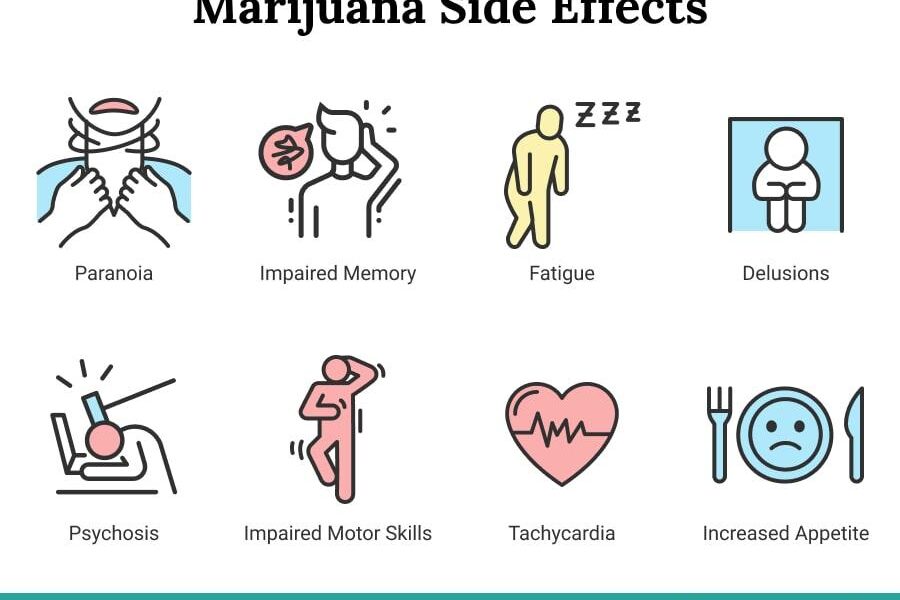Title: The Green Ripple: Exploring the Effects of Marijuana
As the leaves of the cannabis plant dance in the gentle breeze, they carry with them a multitude of effects that have sparked a conversation as complex as the plant itself. From ancient rituals to contemporary debates, marijuana has woven its way through the fabric of society, eliciting a spectrum of reactions—curiosity, skepticism, and advocacy. In this exploration, we delve into the multifaceted implications of marijuana consumption, examining its effects on the mind, body, and community at large. Whether you are a seasoned connoisseur or a curious newcomer, understanding these effects is essential in navigating the ever-evolving landscape of cannabis culture. Join us as we illuminate the science behind the smoke and uncover the ripple effects that extend far beyond the high.
Table of Contents
- Exploring the Psychological Impact of Marijuana Use
- Unraveling the Relationship Between Marijuana and Physical Health
- Understanding the Societal Implications of Marijuana Legalization
- Practical Recommendations for Responsible Marijuana Consumption
- Q&A
- To Conclude
Exploring the Psychological Impact of Marijuana Use
The psychological ramifications of marijuana consumption can vary widely among individuals, reflecting the complexities of human behavior and mental health. Users often report a spectrum of experiences, from enhanced creativity and relaxation to the more challenging effects of anxiety or paranoia. Social interactions may also change; some find that marijuana alleviates social anxiety, making it easier to connect with others, while for others, it can exacerbate feelings of isolation and discomfort in social settings. The effects can be influenced by various factors including the strain of marijuana used, the method of consumption, and the user’s psychological state before usage.
Understanding these impacts provides a clearer view of how marijuana affects mental well-being. Here’s an outline of some notable psychological effects:
- Short-term Memory Impairment: Many users experience challenges with concentration and memory retention during the high.
- Altered Mood: Marijuana can lead to fluctuations in mood, with some feeling euphoric while others may face depressive feelings after its effects wear off.
- Increased Anxiety: Paradoxically, while some users seek relief from anxiety, others may find that marijuana exacerbates their anxiety over time.
| Mental State | Common Response |
|---|---|
| Calm | Increased focus and creativity |
| Paranoid | Heightened fear and discomfort |
| Relaxed | Enhanced sociability and laughter |
| Withdrawn | Feelings of isolation and detachment |
Unraveling the Relationship Between Marijuana and Physical Health
The intricate dynamics of marijuana consumption and its impact on physical health have captured the attention of researchers and the public alike. While some studies suggest potential therapeutic benefits, such as relief from chronic pain and nausea, the substance is not without its risks. Its psychoactive component, THC, can lead to temporary alterations in coordination and judgment, raising concerns about physical activities. Additionally, the method of consumption can significantly affect health outcomes; for instance, smoking marijuana could introduce harmful toxins into the lungs, potentially paralleling the risks associated with tobacco use.
Conversely, alternative methods like edibles or oils may mitigate some of these respiratory concerns while still providing the active compounds that users seek. The relationship between marijuana and physical health encompasses a wide array of factors, including dosage, frequency of use, and individual health conditions. Here are some potential effects to consider:
- Pain relief: Effective for conditions like arthritis or migraines.
- Appetite stimulation: Beneficial for individuals undergoing treatments that cause nausea.
- Cognitive impairment: Short-term memory and reaction times can be affected.
- Cardiovascular concerns: Elevated heart rate and potential blood pressure changes.
To visualize the contrasting perceptions of positive and negative effects, the following table summarizes common health-related outcomes associated with marijuana:
| Effect | Positive Outcomes | Negative Outcomes |
|---|---|---|
| Pain Management | High effectiveness for chronic pain relief | Potential dependency or abuse |
| Sleep | Improves sleep for some users | Possible disruption of sleep cycles |
| Respiratory Health | Can reduce bronchial inflammation | Risks associated with smoking |
| Mental Health | May alleviate anxiety in some cases | Can induce paranoia or anxiety in others |
Understanding the Societal Implications of Marijuana Legalization
The legalization of marijuana is reshaping various facets of society, prompting discussions that extend beyond mere recreational use. Societal norms, health policies, and economic dynamics are all subject to the ripple effects of this significant change. One notable aspect is the shift in public perception; as more people witness the benefits reported by users, stigma surrounding marijuana is gradually diminishing. This has encouraged open conversations about its medicinal value, leading to a broader acceptance of its use for therapeutic purposes in conditions such as chronic pain, anxiety, and epilepsy, thereby redefining how we think about treatment options.
Moreover, the economic implications of marijuana legalization can no longer be overlooked. New industries are emerging, creating job opportunities and generating tax revenue that can be reinvested into local communities. The following points highlight key societal implications:
- Job Creation: Cannabis-related businesses are opening at a rapid pace.
- Tax Revenue: Legal sales can contribute significantly to state and local budgets.
- Criminal Justice Reform: Reducing penalties for marijuana possession can decrease incarceration rates.
- Public Health Initiatives: Funds can be redirected towards education and addiction prevention programs.
Practical Recommendations for Responsible Marijuana Consumption
Responsible marijuana consumption involves understanding both the product and individual preferences to ensure a safe experience. Start low and go slow—for beginners, it’s essential to begin with a lower dose and gradually increase until the desired effects are achieved. Remember, everyone’s tolerance levels vary; hence, listening to your body’s responses is crucial. Additionally, consider the method of consumption you choose: whether smoking, vaping, edibles, or tinctures, each method has a different onset time and duration of effects, influencing your overall experience.
Moreover, always be aware of your surroundings and the legalities of marijuana use in your location. Engaging in consumption in a safe, comfortable setting can enhance the experience while reducing paranoia or discomfort. It’s valuable to stay hydrated and have healthy snacks nearby, as marijuana can sometimes lead to increased thirst and hunger. To help you choose wisely, here’s a quick reference table highlighting popular strains and their common effects:
| Strain | Type | Common Effects |
|---|---|---|
| Blue Dream | Sativa-dominant | Uplifting, Relaxing |
| Granddaddy Purple | Indica | Sleepy, Euphoria |
| Green Crack | Sativa | Energetic, Focused |
| OG Kush | Hybrid | Relaxation, Happy |
Q&A
Q&A on the Effects of Marijuana: Unraveling the Green Enigma
Q: What is marijuana, and what are its primary components?
A: Marijuana, derived from the Cannabis plant, contains over 100 different chemical compounds known as cannabinoids. The two most prominent are delta-9-tetrahydrocannabinol (THC), responsible for the psychoactive effects or the ”high,” and cannabidiol (CBD), which offers therapeutic benefits without the intoxicating effects.
Q: How does marijuana affect the brain?
A: THC binds to cannabinoid receptors in the brain, triggering a cascade of effects, including altered perception, euphoria, and relaxation. However, it can also lead to impairments in short-term memory, attention, and motor coordination, particularly in inexperienced users.
Q: Are there potential medical benefits associated with marijuana?
A: Indeed, numerous studies suggest that marijuana may alleviate chronic pain, reduce inflammation, ease anxiety, and improve symptoms related to conditions such as multiple sclerosis and epilepsy. CBD, in particular, is touted for its potential in managing anxiety and seizures without producing a high.
Q: What are the risks associated with marijuana use?
A: While many people use marijuana without adverse effects, it can pose risks, especially for frequent users or those with predisposed mental health issues. Potential risks include dependence, cognitive impairment, increased heart rate, and exacerbation of anxiety or paranoia. Long-term use may also lead to respiratory issues if smoked.
Q: Can marijuana impact mental health?
A: The relationship between marijuana and mental health is complex. Some studies indicate that heavy use, especially in adolescents, may correlate with an increased risk of anxiety, depression, and psychosis. However, cannabis is also explored as a potential treatment for certain mental health conditions, balancing its therapeutic versus detrimental impacts requires careful consideration.
Q: How does method of consumption influence the effects of marijuana?
A: Absolutely! The method of consumption—whether smoked, vaporized, ingested as edibles, or applied topically—affects both onset time and intensity of effects. Smoking or vaping leads to quicker effects, while edibles take longer to metabolize, often resulting in a more prolonged experience. The form also dictates dosage variability, making it crucial for users to start low and go slow.
Q: What should individuals consider before using marijuana?
A: Potential users should reflect on their personal health history, legal implications in their region, and potential interactions with other medications. Consulting a healthcare professional, particularly for those with existing conditions, can provide tailored advice. Understanding one’s own body’s response to cannabis is paramount to ensuring a safe and enjoyable experience.
Q: How does legalization affect marijuana research and public perception?
A: The ongoing trend towards legalization opens the door for more comprehensive research into both the benefits and risks of marijuana. As societal attitudes shift toward acceptance, this may encourage informed discussions and educate the public about both its therapeutic potential and cautionary aspects, helping to debunk myths and encapsulate a more balanced understanding.
Q: What does the future hold for marijuana research and its effects?
A: As regulations continue to evolve, we can expect an uptick in research exploring marijuana’s effects on health, mental well-being, and societal factors. The hope is that this influx of knowledge will contribute to clearer guidance on responsible use, therapeutic applications, and nuanced health messages, transforming the green enigma into an informed reality.
To Conclude
the effects of marijuana span a complex landscape marked by both beneficial and adverse outcomes. As society continues to explore and navigate this multifaceted substance, it is essential to approach marijuana with both curiosity and caution. The unfolding narrative surrounding its medicinal properties, potential risks, and evolving legal status invites ongoing dialogue and research.
Whether viewed through the lens of therapeutic potential or recreational use, understanding the full spectrum of marijuana’s effects—physically, mentally, and socially—remains a critical pursuit. As we move forward, let us remain open to new discoveries and insights, fostering a balanced conversation that honors the varied experiences of individuals and communities alike. In this dynamic arena, knowledge will be our guiding light, illuminating paths toward informed choices and deeper comprehension.



